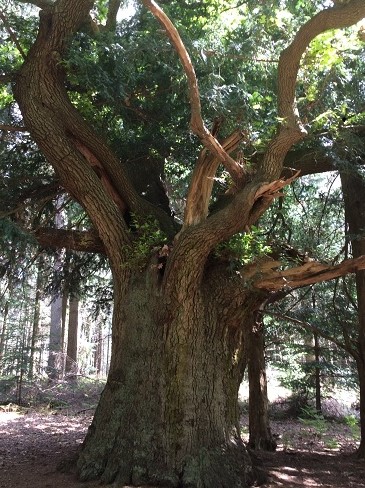
The New Forest is not new as its name suggests and is home to many ancient trees. Remarkably old and full of character, ancient oak and beech trees are a living timeline to the Forest’s past and provide valuable homes to many wildlife species. Seek out an ancient tree and try out these activity ideas to explore and meet these remarkable giants up close.
Activity ideas:
How to find an ancient: An ancient oak is 400-800 years old; whilst a beech can reach 300-400 years. An amazing 1,000 ancient and veteran trees* have been recorded in the New Forest so far – the largest concentration in northern Europe!
Open pasture woodland, where the ponies can graze freely such as Denny and Matley Wood, Hollands Wood and Rans Wood, are some of my favourite places to discover an ancient. You can’t miss them – old and gnarled, with a wide trunk they have many characteristics; burrs (swellings), missing and fallen branches, many have hollow trunks and are often covered in lichen and ferns. Just like people they develop more character with age.
Hug and age a tree: Now you’ve found an ancient you’ll be curious to know its age. Most trees add about 2.5cm (one inch) to their circumference (girth) every year. Measuring up from the ground, approx. 1.5m – an adult arm span – hug the tree at this height. An ancient oak tree will need 4 adult hugs to link arms around its huge trunk – 6m girth, approx 400 years old; an oak 6m+ has exceptional conservation value!
*A veteran is the next generation of ancients – they are slightly younger in age but have many features of ancientness.
In a giant’s presence: There is something special and humbling to sit on the ground with your back against a truly old tree. Take a few moments to wonder …. There’s an adage which says oaks grow for 300 years, rest for 300 years and slowly decline for another 300 years. At what stage of its life is your tree?
Habitat hotel: During the day the tree will have many visitors such as treecreepers and nuthatches looking for insects hiding within its deeply fissured bark. They can be home to nesting woodpeckers and redstarts and at night the nocturnal residents emerge – tawny owls and bats. Visit a tree at dusk and look for bats silhouetted against the sky on their hunting forays.
Amazing characters: Stand back to admire your tree – can you see faces – an eye, nose, mouth? Take a hand mirror and look up under its canopy. Imagine you are a jay or a squirrel, hopping and jumping from branch to branch. Look closely – maybe there’s a secret fairy door or a hidden staircase.
Forests for wellbeing: Share your #MyForestMoment of nature connection with Forestry England. Check out https://www.forestryengland.uk/wellbeing to learn how trees can benefit you.
Don’t be a stranger: Revisit your friend throughout the year- you’ll find the tree will look completely different in winter with its shape revealed, and in autumn weird and wonderful fungi grow in association with the roots.
